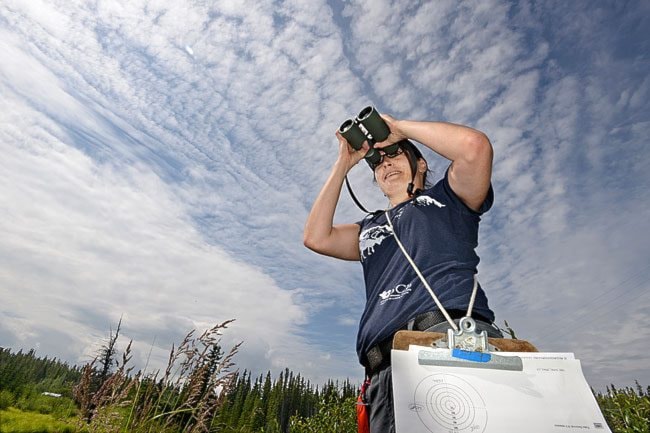The sun is shining, the surface of the pond is shimmering, the marsh grasses are waving. The dragonflies flit back and forth above the water, their iridescent bodies glittering in the sunlight.
And then - the sharp flash of a butterfly net slicing through the air. A single dragonfly disappears into the folds of nylon.
Crispin Guppy, a biologist and butterfly expert, reaches into his net and pulls out his captive. He holds it by its wings and shows it to the small group of volunteers clustered around him. Its legs wave as it struggles to escape. Guppy points out the blue markings on the long, slender abdomen and the gold and green stripes at the base of the wings. This one, he says, is a darner.
One of the volunteers, Cheyenne Bradley, reaches out tentatively to touch the insect. It’s clear she has mixed feelings about it.
“I just like how they look,” she said. “But if they were in my hand, I’d probably freak out a little.”
Bradley, 18, was one of a group of volunteers of all ages who attended the first annual BioBlitz at McIntyre Creek last weekend. They were there to help local biologists like Guppy build an inventory of all the species they could find in and around the creek: plants, fish, birds, mammals, and insects - including dragonflies.
The event, organized by the Yukon Conservation Society, aimed to gather information about McIntyre Creek’s biodiversity to help protect it against future development proposals. But it was also designed to teach local people like Bradley about all the plants and animals living right in their backyards.
Before the BioBlitz, Bradley didn’t know much about birds or insects. She’s just finished her first year at Yukon College and is part of the Yukon Youth Conservation Corps - a summer job program ran by the Department of Environment. She hopes that experiences like this will help her get a job as a conservation officer one day.
“I love animals. I love being outdoors,” she said. “I’ve learned different species of birds and I’m learning about what different types of dragonflies there are.
“But I don’t remember the names,” she added. “It’ll take me a while to remember the names.”
BioBlitzes are a common citizen science event in southern Canada, but this was a first for Whitehorse.
Christina Macdonald, executive director of the Yukon Conservation Society, said she chose to focus on McIntyre Creek because it’s an important recreational area for Whitehorse residents. Last year, the city adopted a regional parks plan for McIntyre Creek and four other local parks. Macdonald said the BioBlitz will help provide more specific information about the area’s biodiversity, which could help guide management decisions.
“It made a lot of sense… because of the enormous love the community has for this area,” she said.
McIntyre Creek was at the centre of a development controversy in 2011, when the city nearly decided to develop part of the area around the creek to build the Porter Creek D subdivision.
That project was eventually shelved, but Macdonald pointed out that the area is still zoned for development.
“It’s definitely a very real threat still, unfortunately,” she said. “[City council] didn’t vote to protect the area. They voted to postpone planning. So council could reverse that decision at any minute.”
Macdonald said the area serves as important bird and fish habitat, and as a wildlife corridor for larger mammals.
For the BioBlitz, biologists chose eight sites in McIntyre Creek that represented the different habitat types in the area. Then biologists and volunteers moved from site to site, making lists of all the plants, insects, birds, and mammal tracks they could find.
In the creek itself, fisheries technician Paul Sparling set out minnow traps to assess the creek’s fish population.
The creek is too small to serve as salmon spawning ground, but chinook salmon fry use the creek to feed for their first summer, before heading out to sea.
Sparling said he found lots of juvenile chinook in the creek, though he found the largest number below the Range Road bridge. That could mean the salmon are having a hard time getting through the culvert beneath the bridge.
He also found more rainbow trout and fewer Arctic grayling than he did the last time he assessed the creek in 2006. He said that could be a sign that the introduced rainbow trout are out-competing the native grayling.
Overall, though, he said the creek is doing well.
“It’s very healthy and in a unique way because it’s probably one of the most extensively altered ecosystems in the Yukon,” he said. “It’s got all the bridges and roads crossing it. It’s got huge fishing pressure.”
Macdonald plans to publish a report with the complete species list later this summer. She also hopes to make the BioBlitz an annual event, so biologists and volunteers can build up the list for years to come.
Back at the pond, the BioBlitz was as much about having fun as it was about science. At one point, one of the volunteers went tearing off after a small, white butterfly, his net waving in the air.
“Accuracy and speed,” said Guppy as the young man disappeared. That’s what it takes to make a good butterfly catcher.
Soon after, the volunteer returned to the group, his net empty except for a few leaves.
Speed, he’s got nailed down. Accuracy, he’ll have to work on. Maybe next year.
Contact Maura Forrest at
maura.forrest@yukon-news.com
